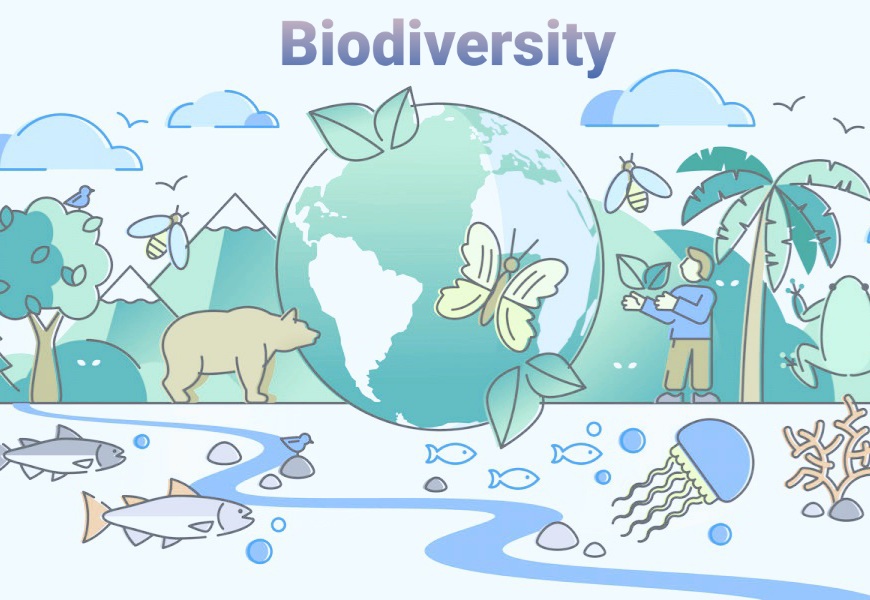Table of Contents
What is Biodiversity?
The term biodiversity (from “biological diversity”) refers to the variety of life on earth at all its levels, from genes to ecosystems, and can encompass the evolutionary, ecological, and cultural processes that sustain life.

Biodiversity includes not only species we consider rare, threatened, or endangered but also every living thing from humans to organisms we know little about, such as microbes, fungi, and invertebrates.
usually the measured of biodiversity is genetic diversity a measure of how many distinct genetic species there are in an area or a population
Why is Biodiversity Important?
Biodiversity is important to most aspects of our lives. We value biodiversity for many reasons, some utilitarian, some intrinsic. This means we value biodiversity both for what it provides to humans, and for the value it has in its own right. Utilitarian values include the many basic needs humans obtain from biodiversity such as food, fuel, shelter, and medicine. Further, ecosystems provide crucial services such as pollination, seed dispersal, climate regulation, water purification, nutrient cycling, and control of agricultural pests.
Biodiversity also holds value for potential benefits not yet recognized, such as new medicines and other possible unknown services. Biodiversity has cultural value to humans as well, for spiritual or religious reasons for instance. The intrinsic value of biodiversity refers to its inherent worth, which is independent of its value to anyone or anything else. This is more of a philosophical concept, which can be thought of as the inalienable right to exist.
Finally, the value of biodiversity can also be understood through the lens of the relationships we form and strive for with each other and the rest of nature. We may value biodiversity because of how it shapes who we are, our relationships to each other, and social norms. These relational values are part of peoples’ individual or collective sense of wellbeing, responsibility for, and connection with the environment.
The different values placed on biodiversity are important because they can influence the conservation decisions people make every day.
Types of biodiversity

1. Genetic Diversity
It is the diversity expressed at the genetic level by every single person in a species. No two individuals of the same species are accurately similar. For instance, humans show a lot of biodiversity between themselves. People living in different areas show a great level of differences.
2. Species Diversity
It is the biodiversity seen within a community. It signifies the number and distribution of species. The number of species in an area varies broadly according to the environmental surroundings. For instance, it is usually observed that a human society living nearby the water bodies display more species than the one compared to the areas far from water bodies
it refer to tha variety of species with in a region such diversity could be measured by on the basis of no of species in a region.
Biodiversity at its most basic level include for all region of species on the earth from microorganisms such as virus and bacteria.
3. Ecosystem diversity
In an ecosystem there exit different landform each of which support different and specific vegetation.
Ecosystem diversity describes the full variety of ecosystems of an area, while the term “ecosystem” describes all the organisms in an area, as well as the physical and chemical environment with which those organisms interact.
Ecosystem diversity is difficult measure since presence of boundaries of communities which constitute the various subecosystem are not clear.
Conservation of Biodiversity
Conservation of biodiversity through a network protecting area including national parks, gene banks, wet lands etc.
The variability of life on earth is called Biodiversity. Biodiversity takes into account all the living organisms present on earth. Healthy and good biodiversity indicate a healthy and good ecosystem. Hence, biodiversity is very important. A healthy ecosystem also includes the availability of pure water, pure air, healthy land, a good climate, and the availability of nutrients on earth. Therefore, biodiversity conservation plays an important role in the quality of life of all living organisms.
Types of Conversation Biodiversity

1. In-situ Conservation
In-situ conservation, the conservation of species in their natural habitats, is considered the most appropriate way of conserving biodiversity.
Conserving the areas where populations of species exist naturally is an underlying condition for the conservation of biodiversity. That’s why protected areas form a central element of any national strategy to conserve biodiversity
2. Ex-situ Conservative
Ex-situ conservation is the preservation of components of biological diversity outside their natural habitats. This involves conservation of genetic resources, as well as wild and cultivated or species, and draws on a diverse body of techniques and facilities. Some of these include Gene banks, e.g. seed banks, sperm and ova banks, field banks etc.
